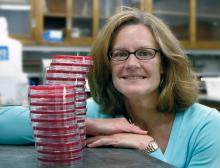
Research for countering threats from bioterrorism agents and infectious diseases will be conducted at the University of California, Santa Barbara, funded by a $1.5 million grant over four years by the National Institute of Allergy and Infectious Diseases of the National Institutes of Health (NIH).
UCSB microbiologist Peggy Cotter has been selected as a project director in the newly established Pacific-Southwest Regional Center of Excellence (RCE) for Biodefense and Emerging Infectious Disease Research---one of only ten NIH-funded centers in the nation dedicated to research aimed at countering bioterrorism and emerging infectious diseases.
"Our goal," said Cotter, "is to gain a fundamental understanding of how certain bacteria cause disease, and then to use that knowledge to identify potential vaccine components and targets for new antibiotics and therapeutic drugs."
Some of the funds will be used to construct a state-of-the-art, high security, biosafety laboratory at UCSB in which the work will be conducted.
The Pacific-Southwest RCE was established with a $40 million grant awarded to UC Irvine. The Center is directed by Alan Barbour, M.D, an infectious disease expert at UC Irvine, who is internationally known as co-discoverer of the bacterium that causes Lyme disease.
The Center is a consortium of 16 universities and research institutes in California, Arizona, Nevada, and Hawaii. "Its mission," said Barbour, "is to bolster basic biomedical research into bioterrorism agents, such as those that cause anthrax and botulism, and naturally occurring infectious diseases, including West Nile virus, hantavirus and dengue---diseases that are affecting increasing numbers of people worldwide. The Center also will provide scientific support, expertise and facilities in response to a national emergency, such as a terrorist attack or an epidemic of a new infectious disease, like the SARS virus."
Cotter, assistant professor of Molecular, Cellular and Developmental Biology at UCSB, will serve as director of "Project 4," one of six research projects within the Pacific-Southwest RCE. In addition to Cotter, Project 4 investigators include David A. Low, professor and vice-chair of Molecular, Cellular and Developmental Biology at UCSB; Jeffery F. Miller, professor and M. Philip Davis Chair of Microbiology, Immunology and Molecular Genetics at UCLA; Paul Keim, Regents' Professor and Cowden Chair of Microbiology at Northern Arizona University; and Thomas Kozel, professor and chair of Microbiology and Immunology at the University of Nevada, Reno.
These investigators will apply their extensive combined experience studying bacterial and fungal pathogens. These pathogens include Bordetella pertussis (which causes whooping cough), uropathogenic Escherichia coli (which causes urinary tract infections and kidney disease), Listeria monocytogenes (which causes gastroenteritis in healthy people but is a life-threatening disease in immunocompromised individuals, pregnant women and infants), and Cryptococcus neoformans (which causes meningitis and systemic illness in immunocompromised individuals).
The researchers will seek to understand the basic pathogenic mechanisms used by newly emerging pathogens and bioterrorism agents. "Our team will investigate how a potential bioterrorism agent causes pneumonia and septicemia," said Cotter. "We will focus on understanding how this bacterium first makes contact with human tissues. Bacterial proteins that mediate this initial interaction typically make good vaccine components because if you can block that initial interaction, you can prevent the infection from getting established in the first place."
Both Cotter and Low have extensive experience studying these kinds of proteins, called adhesins, in other bacteria. Cotter has been studying members of the Bordetella genus (including B. pertussis) since 1992. She showed that an adhesin called filamentous hemagglutinin (FHA) is absolutely required for these bacteria to infect the lower respiratory tract. Recent work in her laboratory indicates that FHA plays critical roles in determining host specificity and the severity of the disease that develops.
Low has been studying adhesins in a variety of bacterial pathogens for over 20 years, with much of it focused on uropathogenic E. coli (called UPEC). He has made several seminal contributions to understanding the regulation of a special class of adhesins called Pap pili. Pap stands for pyelonephritis-associated pili, and, as their name suggests, these adhesins play an essential role in allowing UPEC to travel to the kidneys where they cause infection.
"The large genome of the bacterium that we will be studying as part of the RCE has been sequenced and we have already identified genes with the potential to encode pili and an FHA-like protein," said Cotter. "We are anxious to see if they behave like the adhesins that we have been studying in Bordetella and UPEC. If so, we will immediately begin experiments to see if they can induce protective immunity and work with other researchers in the RCE to facilitate vaccine development."
Other Regional Centers of Excellence for Biodefense and Emerging Infectious Diseases are based in Colorado, Washington, Texas, New York, Massachusetts, Illinois, Missouri, Maryland and North Carolina.
Related Links



